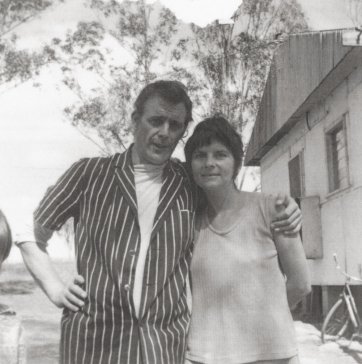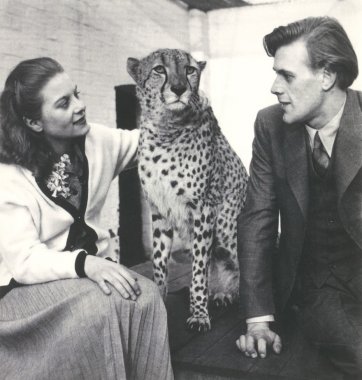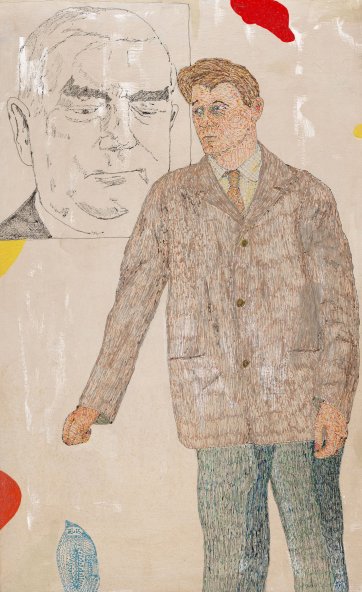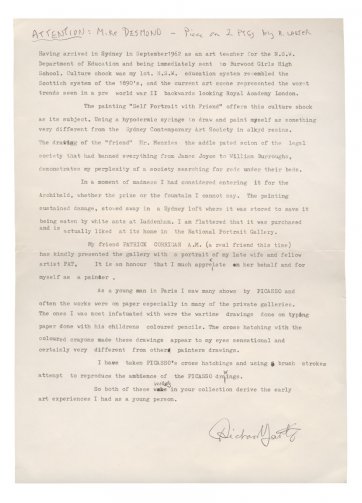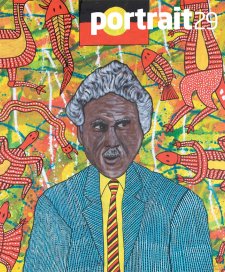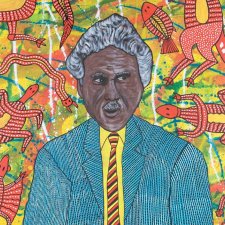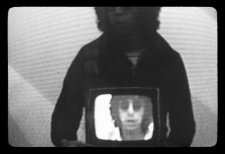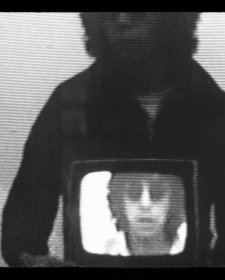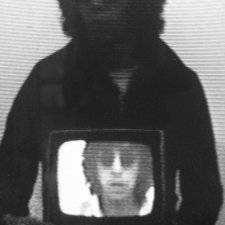Richard Larter’s art sparkles, vibrates and pulses with energy. Working as an artist for over fifty years he has joyfully celebrated the vital power of human sensuality and powerfully decried political and social hypocrisy.
He has experimented with the style and composition of his paintings, embracing figurative and abstract imagery and exploring unconventional painting techniques and mediums. His work is currently the subject of a major retrospective exhibition at the National Gallery of Australia curated by Dr Deborah Hart.
Larter was born in London in 1929 and with his wife Patricia (1936-1996) and their young family, moved to Sydney in 1962. In England Larter studied art as a teenager, was conscripted into the British Army for a short period and travelled to Europe and North Africa to study art and culture first-hand. As a trainee marine surveyor in the early 1950s Larter met Patricia Holmes, and they were married in 1953. Pat, as she was known, became Richard Larter’s long-time muse and collaborator. Pat and Richard began working together around 1966, each maintaining their own art practice while collaborating on experimental film works, performance works, and working as creative partners for Richard’s many portraits of Pat. In the mid 1950s Richard worked as a secondary school teacher in England, and in 1962 the Larter family immigrated to Australia. Shortly after arriving in Sydney the Larters settled at a bush property at Luddenham, south-west of Sydney. As Larter has recalled, ‘there was an endless sky never broken by buildings, and real stars not hidden by city lights’.
Before moving to Australia Larter had been experimenting with painting techniques and was inspired by seeing a box of hypodermic syringes displayed in a medical supply shop window: ‘Something like St Paul on the road to Damascus I had this vision of myself filling a syringe with paint and varying the finger pressure on the plunger, almost writing with paint.’ The use of the syringe as a painting tool gave Larter’s work a distinctive look, and in 1965 he used this technique in his painting Self portrait with pinup, purchased by the National Portrait Gallery with funds from the Basil Bressler Bequest in 2002. This portrait was borrowed by the National Gallery of Australia for inclusion in his retrospective. In Australia, however, Larter found it increasingly difficult to obtain syringes. His painting style evolved but was often characterised by the use of linear pattern-making. In Larter’s 1983 painting Pat painting No.1, recently gifted to the National Portrait Gallery by Patrick Corrigan AM, Larter uses patterned stripes and cross-hatched lines to define the shadows and contours of Pat’s face and upper torso. Pat poses infront of an earlier Larter painting in which an unidentified female figure is visible, the multi-coloured stripe background also animating the space around Pat’s face. Pat’s performed pose consciously refers to the loaded representations in visual culture of female subjects as the object of the male gaze. Simultaneously the painting acknowledges the Larters’ affection for each other.
Michael Desmond, the National Portrait Gallery’s senior curator, asked Richard Larter to provide a commentary on the two paintings and it his response that is reproduced here. In his note Larter evokes the social context that informed his 1965 self portrait (where the title of the work describes it as a self portrait with ‘pin-up’, Larter here refers to the pin-up ironically as a ‘friend’); and his enthusiasm for drawings by Pablo Picasso that inspired his portrait of Pat.
